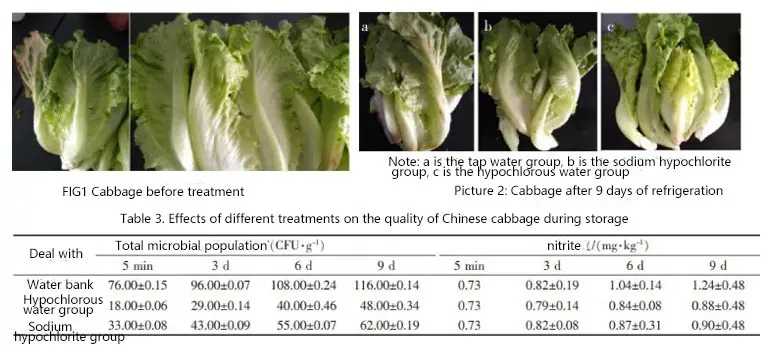Hypochlorous acid used in fruit and vegetable processing cleaning, sterilization, preservation
After fruit and vegetable picking, the tissue metabolism is vigorous,which is easy to lose water,brown and rot,and can not withstand storage at normal temperature,Moreover,many microorganisms that accelerate the freshness decline and quality deterioration of fruits and vegetables,and the growth and propagation of some pathogens will directly affect the edible safety of fresh fruits and vegetables and endanger human health. The use of chemical fertilizers leads to more residual nitrite and nitrate in fruits and vegetables , The nitrate can be converted into nitrite under the action of nitrate reductase or microorganisms in plants, Excessive intake of nitrite will cause poisoning.In order to maintain the freshness and safety of fruits and vegetables during transportation and storage,fruits and vegetables during transportation and storage,fruits and vegetables after picking are usually sterilized to reducethe number of microorganisms

Study on the sterilization and preservation of Chinese cabbage with hypochlorous water
After 9 days of sealed storage at 4℃,before and after comparison (FIG.1), compared with tap water treatment,leaves of Chinese cabbage showed Browning in damaged parts,while the other treatment groups were significantly less.Meanwhile,leaves of 3 groups showed wilt but no rot , as shown in FIG .2 ,The bactericidal effect of soaking and cleaning lettuce for 5 min in different solutions showed that hypochlorous water was greater than sodium hypochlorite than tap water, The reason why hypochlorous water is superior to sodium hypochlorite is that the active chlorine component in sodium hypochlorite sodium hyochlorite solution is mainly CLO- ,while the active component of hypochlorite water is mainly HCLO. HOCL has strong oxidation ability and the ability to penetrate cell membrane,which can more effectively destroy the cell menbrane structure of microorganisms and kill microorganisms, This is because the effective chlorine content in tap water is very low,soaking and cleaning can only remove a small part of microorganisms,and the treatment result is significantly different from that of hypichlorous acid(P<0.05)

Conclusion
1:Bactericidal effect of hypochlorous water
In 100mg/L hypochlorous water sterilization experiment, Escherichia coli,Salmonella, Staphylococcus aureus and Candifa albicans can be effectively killed within 1 min,but the killing effect on Bacillus subtilis is poor, and it takes 5 min to achieve the same killing effect. With the decrease of hypochlorous water concentration, the effective bactericidal effect is weakened, To achieve the same bactericidal effect needs to extend the killing treatment time, The United states Food and Drug Administration stipulates in FCN1811 that hypochlorous acid water can be used as a leave-in disinfectant when the maximum concentration of 60mg/L is used in food, In this study, 50mg/L hypochlorous acid water can kill a variety of non-bacillus and yeast within 2 min
2:Study on the sterilization and preservation effect of hypochlorous acid water on Chinese cabbage
The effect of using 50mg/L hypochlorous water and sodium hypochlorite disinfectant to clean and disinfect lettuce is obviously better than tap water, and can effectively inhibit the production of nitrite during the refrigeration process of Chinese cabbage. The sterilization and inhibition effect of hypochlorous water is better than that of sodium hypochlorite solution with the same concentration. Inaddition, VC vegetables,which can avoid Browning in the process of refrigeration, affecting the appearance and quality of vegetables
